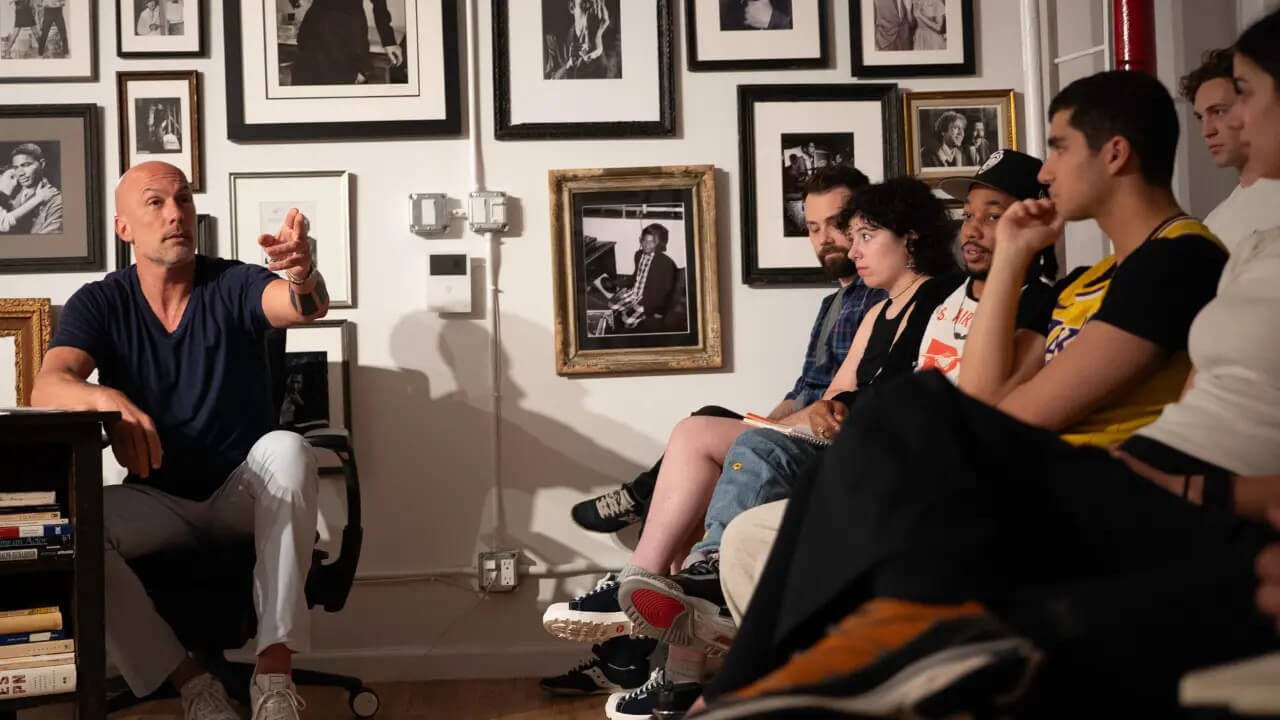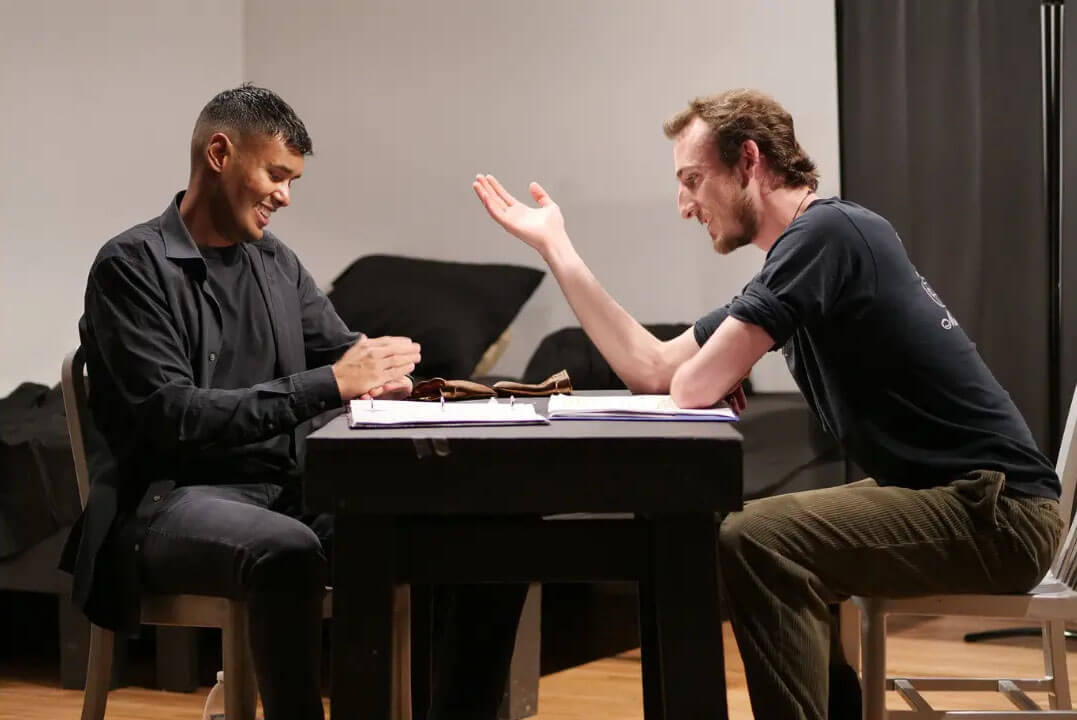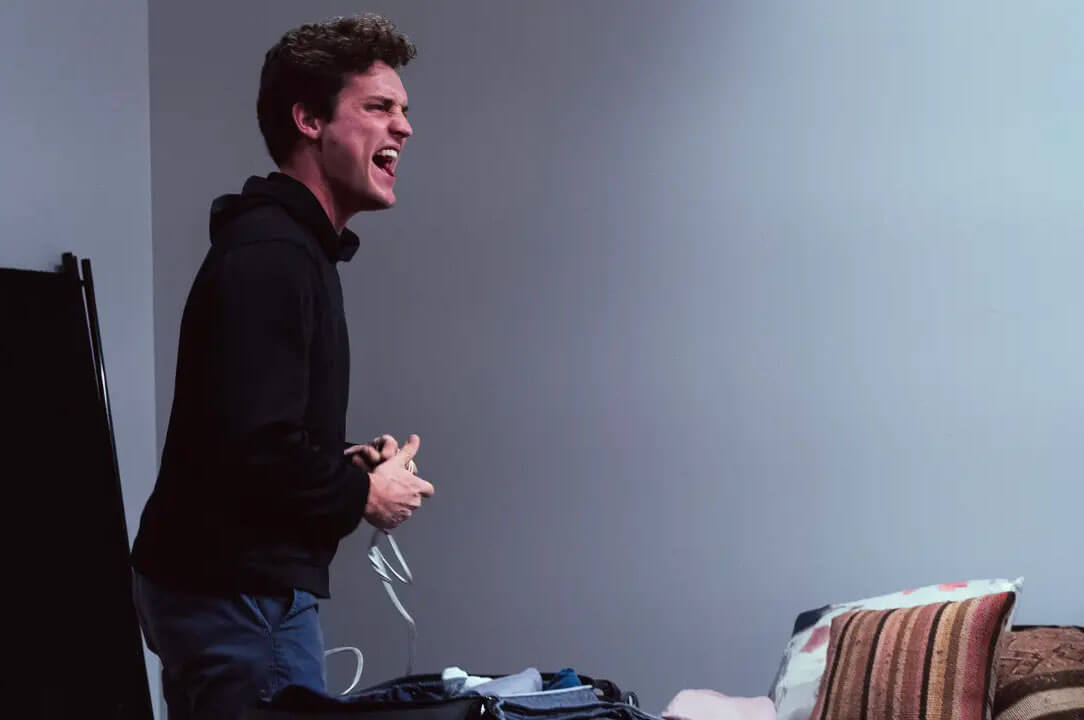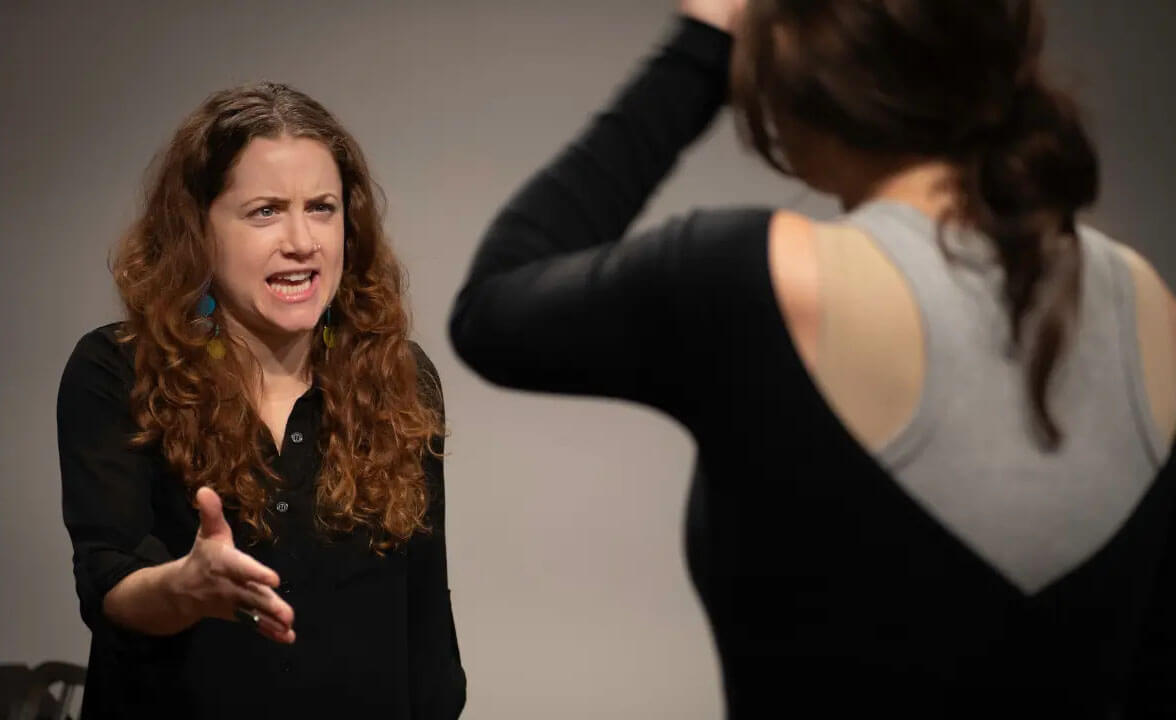APPLY FOR ADMISSION
FIRST YEAR MEISNER ACTING PROGRAM

BEGINS
SEPTEMBER 10TH

Call To Schedule an Interview
(917) 794-3878
The Meisner Approach to Emotional Acting Techniques
The world of theater has always been captivated by performances that resonate with authenticity, drawing the audience into the character’s experience.
An audience lives vicariously through the actors they are watching, and if the actors are emotionally alive and present, the audience has a feeling response as well.
Emotional acting techniques are key to compelling acting. When it comes to professional actor training, the Meisner method holds a distinguished place for actors aiming for emotional depth in their work.
As you journey with us through this article, you’ll uncover the intricacies of the Meisner Technique—a method that has trained thousands of professional actors over the last 85 years.
You’ll also discover how this technique makes it possible for actors to transcend mere scripts and breathe life into their characters, making every scene unforgettable.
Key Takeaways
- The Meisner Technique emphasizes spontaneity and emotional truth, rooted in the actors’ imagination, which is one of the big differences with the training created by Lee Strasberg known worldwide as the Method Acting Technique.
- The seed of Meisner’s approach is the repetition exercise, which trains actors to get the attention off of themselves, and onto the other person, fully present in the moment, with emotional depth and vulnerability.
- While many acting techniques prioritize personal experience, Meisner champions the use of vivid imagination. He believed this was a more creative and healthier approach to working with the unconscious. The Meisner Technique does not teach an actor to use their actual pat, the literal traumas, and tragedies, in order to manipulate an actor’s emotional life.
Historical Foundations of the Meisner Technique

The quality of acting has been much improved over the 20th century by various acting techniques, each offering its own perspective and approach to the craft of acting.
At the heart of these techniques, the Meisner Acting Technique stands out. It is distinguished by its clarity and results.
Sanford Meisner, beyond being an accomplished American actor, was a revered acting teacher who dedicated his life to refining and teaching his methodology. Rooted in the traditions set forth by Constantine Stanislavski, Meisner carved out his own niche.
While Stanislavski emphasized emotional memory, urging actors to draw from past experiences to evoke emotion in scenes, Meisner saw potential pitfalls in this approach. He believed that relying too heavily on memories wasn’t necessary. The imagination is a far more fertile place to create.
As such, Meisner developed a sophisticated improvisational exercise, which begins with a repetition exercise between two people.
About halfway through the full first-year progression, the Meisner Technique introduces emotional preparation, which essentially, is what an actor does off-stage or off-camera in order to connect emotionally to the previous circumstance. It is self-induced emotion, which is an essential part of an actor’s process.
While method actors delve literally into their past, using emotional memory to manipulate emotion, Meisner-trained actors learn how to use their ability to daydream and fantasize, and harness that to their craft.
Emotional access is not necessary to be a really good actor, but it does allow an actor to tackle a broad range of characters and provide a better experience for the audience.
The Unique Nature of Emotional Preparation

The Meisner approach distinguishes itself by emphasizing the authenticity and depth of an actor’s emotional state. There’s more to it than just words on a page. It goes beyond merely memorizing the script or practicing how to say your lines, which is amateurish.
The craft of acting, particularly the Meisner technique, prizes spontaneity, and the ability for an actor to respond personally from unanticipated moment to unanticipated moment.
When a Meisner-trained actor is handed a scene that requires certain emotions such as anger or joy, they don’t indicate the emotion. Instead, with vulnerability, empathy, and a solid process, a Meisner actor creatively and authentically steps into the shoes of another human being.
Training this way will instill in any serious actor a process that will allow for consistency in creating organic, vivid, fully realized human behavior.
On top of that, this technique resonates with an audience not only because of the quality of emotion from the actors, but also because it’s authentic, and not something phony or indicated.
An audience lives vicariously through the actors on stage or on camera, and if the actor is genuinely alive internally, the audience will be moved in some way.
Unpacking the Meisner Acting Technique Essentials

The Meisner Technique, like all refined acting techniques, does not just jump into the deep end. It methodically trains its students, starting from the basics and gradually progressing in its sophistication. This goes a long way to providing consistency in the quality of an actor’s work.
Word repetition: The cornerstone of Meisner training
One of the primary exercises in the first year of the Meisner Technique is word repetition. This exercise isn’t merely about parroting words. Rather, it’s a foundational tool that cultivates an actor’s ability to listen and respond personally from moment to moment.
As actors repeat what was just said to them by the other, they begin to address one of the core fundamentals of acting—placement of concentration. For the actors, the attention should not be on themselves, but always placed on either the other person or what they are doing.
This is the first big step in getting the actor on their spontaneous impulses, and fully present in the moment. Over time, the repetition is eventually removed, and the actors are responding personally in every moment from a personal point of view. When this gets brought to scene work, the results can be stunning.
The organic development of emotional nuance
The beauty of the repetition exercise lies in how it organically develops emotional fluidity.
As actors focus on their scene partner’s words and subtext, the repetition exercise begins to start to sensitize the actor, chiseling away at the barriers and defenses that have been formed and utilized for decades, in order to stay safe and unhurt.
A well-trained Meisner actor is a vulnerable and empathic actor, capable of being played upon and changed from moment to moment.
This training emphasizes the importance of listening intently, allowing actors to react authentically to what’s happening in every moment.
Moving beyond words to genuine emotional exchanges
Meisner believed that words were as important as how they were being said. Acting is essentially a subtext exercise, and an actor who is fully present, responding to how they are being treated will keep a performance vital and alive.
The real magic happens when actors can be changed by the tone of a voice, the roll of an eye, a slight hesitation, or the faintest sigh. This is what the best actors can do.
When an actor can work this way, but also has emotional depth and empathy, a truly dynamic performance can be created.
Progressive complexity: A journey into the depths of acting
As actors delve deeper into the Meisner Technique, the exercise evolves. Actors, eventually, are no longer repeating. Instead, they respond in the moment for how they feel, finding the freedom that comes with spontaneous, personal, moment-to-moment work.
One significant aspect of this progression is the introduction of the independent activity. Acting is the ability to do truthfully under an imaginary circumstance, and the independent activity was created by Meisner to teach an actor how to craft in a simple, specific, and personal way. Acting is doing, not feeling, and the ability to do truthfully is a core fundamental.
First year Meisner also teaches the actor how to craft the acting relationship. Who is the other person to you, and how do you feel about them? The ability to empathically relate to the meaning of the relationships in the script is part of an actor’s job.
If this question is pinned down in a personal way, then the meaning of each moment has more clarity and understanding, which is what the screenwriter or playwright wants.
The Power of Pretense: Shaping Emotional Realities

A key part of an actor’s success rests in bringing a character’s emotional landscape to life. When it comes to crafting and emotional preparation, this is where the imagination plays a crucial role in Meisner’s process.
While the script offers a blueprint, an actor’s genuine contribution comes from their own instincts with the material. An actor must be a detective, reading the script, and seeing in their imagination the behavior that needs to be created. This requires the ability to use your imagination vividly and graphically.
For a performance to resonate, actors dive deep into the full range of human emotions, crafting a comprehensive emotional world that, although fictional, is still genuine. To create such a profound emotional impact on an audience, actors must be able to access the full gamut of human emotion. The best actors can do this.
This doesn’t mean that an actor needs to have literally experienced every emotion or situation personally. Instead, it’s about the ability to empathize, to put oneself in another’s shoes, and to use the power of imagination to fill any gaps. The Meisner Technique lays the foundation for an actor to begin working in this deeply personal way.
When actors speak passionately, they’re not just reciting a memorized line. Instead, they’re sharing a piece of their character’s soul. When they cry because they’re sad or shout in anger, it’s not just for show—it’s the culmination of a deep emotional journey, crafted from both real and imagined experiences.
Any serious actor wants to do justice not only to the script but to their character, breathing life into them, with empathy and artistic integrity.
Harnessing Genuine Emotions: Personal Experience vs. Vivid Imagination

In acting, the debate has long raged over whether actors should rely solely on their own literal experiences to evoke emotion or if the power of a vivid imagination can produce equally compelling results. Both method acting and the Meisner Technique have different approaches.
Many method actors have leaned heavily on their personal memories, a method championed by figures such as Lee Strasberg. Strasberg believed that drawing from one’s own experiences, the pain of a past breakup, or the joy of a cherished memory can provide great detail and nuance to a performance. However, this method has its limitations.
Not every actor has experienced every emotion or situation outlined in a script. On top of that, constantly revisiting painful memories can be unhealthy, emotionally taxing, and unsustainable in the long run.
Sanford Meisner did not agree with this and believed in the ability of actors to develop a vibrant imagination—one that could conceive of and relate to the issues of the character without dredging up personal experiences.
This doesn’t mean emotion should ever be faked, though many bad actors do this all the time. Rather, genuine emotion rooted in the ability to ask “what if” allows for a true connection with the issues in the script.
To cultivate this vivid imagination, actors are encouraged to imagine parallels to a specific circumstance. This requires that an actor daydream in a graphic and vivid way.
As humans, we know that vivid daydreaming can alter our emotional life. Meisner training teaches an actor how to alter their inner life this way, and then attach that organic emotion to the issues of the character. An actor who has a solid way of working, and also has the capacity to work with their emotional pallet this way can do some amazing things.
Immersion and Imagination: Deepening Emotional Connections

Indeed, the Meisner Technique has continued to distinguish itself over the last 80 years, but it’s essential to remember that this methodology serves as a guide rather than a rigid rulebook.
While many actors have been shaped by its teachings, the most significant quality an actor must have is authenticity. Just like any artist does in any art form, attending an acting class is not enough. You must take the technique and make it your own.
Every actor is unique but the nuances of their emotional preparation are deeply personal. There are very few actor training methods that develop emotional depth and vulnerability. This is one of the distinctive features of a Meisner-trained actor. Not only are they rock solid with fundamental skills, but they also have emotional accessibility.
For example, some actors do tremendous research on the character, and the things they are good at, and work diligently in order to disappear into the character. Actors like Cate Blanchet did that kind of research for the movie Tar, as does Tom Cruise with every action movie he makes.
There is a certain amount of obsession that serious artists possess. This hard work, when added to a solid foundation can lead to a vibrant acting career.
Similarly, some actors love personal biography. They will do meticulous imaginative work on a character’s past, their home life, and even their childhood in order to bring more insight to their performance.
Summary
The Meisner Acting Technique has revolutionized the craft of acting, emphasizing authenticity and being fully present in the moment. Founded by Sanford Meisner, the technique diverges from traditional acting methods, like the one created by Lee Strasberg, by stressing the importance of listening to one’s scene partners rather than waiting for cues and indicated responses.
Actors harnessing the Meisner Technique undergo rigorous training. This includes learning how to craft a previous circumstance, an acting relationship, shared circumstances, and the ability to emotionally prepare off-stage or off-camera. The second year of Meisner training focuses on the ability to break down a script and create characters.
The best actors train for a number of years and develop their personal processes for creating behavior. The Meisner acting technique not only serves as the floorboard for an actor’s craft but also encourages them to bring their own creativity and authenticity to what they do.
Elevate Your Acting with Emotional Accessibility
Emotion in acting is an important issue for actors. The thing to remember about it is that quality is more important than quantity.
The fluidity and ease of an actor’s emotional life is very important. Emotion must ebb and flow, and should never be forced or pushed out. This seems like a simple statement to make, but applying this insight in acting is one of the hardest things to grasp.
Acting is an art form, and any serious actor should have a desire to illuminate the human condition in all its aspects. The best actors are acrobats of the human heart, and have the courage to put their soul on the line every time they act. This understanding of the actor as an artist is the foundational principle of the Maggie Flanigan Studio.
Recognized for its unwavering commitment to the craft of acting, the Maggie Flanigan Studio offers specialized acting classes and acting programs that equip actors with the ability to consistently create vivid, organic, fully realized human behavior.
Ready to start taking an acting career seriously? Reach out to Maggie Flanigan Studio today and take that crucial step towards a professional acting career.
Frequently Asked Questions
What is the emotional acting method?
The emotional acting method, as championed by Sanford Meisner, emphasizes vulnerability, empathy, and vivid daydreaming.
The Meisner Technique teaches an actor how to come to life by working off of another human being, truthfully doing something personal, and using vivid daydreaming. These are the three ways an actor can have an emotional experience on stage or on camera.
Instead of drawing from personal experiences, Meisner-trained actors immerse themselves in the present moment, focusing on the other character and the imaginary circumstances provided in the script.
What are the 5 main acting techniques?
The five main acting techniques are Stanislavski’s System, Lee Strasberg’s Method, Stella Adler’s script analysis, Sanford Meisner’s technique, and Michael Chekhov’s process. Each offers a unique approach to understanding and embodying a character, with varied emphasis on emotional memory, physical actions, imagination, and personal experiences.
How do actors act emotional in scenes?
A well-trained actor knows that truthfully doing under imaginary circumstances is the definition of acting. Emotion is wonderful to have, and essential if you want to move an audience, but it won’t solve anything.
Good actors are not emotion-conscious and do not force or strain to squeeze emotion. In life, people do everything they can not to feel. No one walks around day to day trying to feel, and making sure that everyone can see it.
Only bad actors do this. So in truth, good actors never act emotional. They craft well, leave themselves alone, and let the moments take them wherever it takes them.
Recent Post
STUDENT TESTIMONIALS
“I was placed in the intense reigns of Charlie Sandlan. I became a better artist, actor, friend, sibling and daughter because of the studio. Even now, I crave the studio every day. What I learned is present in my work every day. I truly believe in everything they stand for.”

“Maggie taught me that I could control my work, my acting, and to throw all of the bullshit out that I had in my head about ‘what I should be doing’ and to just listen and respond honestly, in the moment. She gave me a craft. She is, quite simply put, THE BEST.”

“Maggie Flanigan taught me the true meaning of artistry, passion, and professionalism. I am certain that I continue to work as an actress because of my training with Maggie. At every audition and every performance, her guiding voice is with me. It is a gift beyond measure.”

“Maggie Flanigan is uncompromising, her instincts as a teacher are razor sharp. She doesn’t miss a beat”

“Maggie Flanigan has been one of the most important people in my artistic life. I want to work with Maggie trained actors. As an actor myself, she is my first source. I do not say this lightly, if you are serious about acting, and willing to work very hard, then go to Maggie.”

“Maggie helped me find my sense of truth, an actors greatest asset. Maggie is an expert at instilling that vital ingredient, which allows an actor’s potential to become limitless. My work will forever be rooted in the clarity and honesty she helped me develop.”

“After working for ten years, I did the 2 year program, and now feel that I have the tools I need to become the actor I’ve always dreamed of being. Maggie Flanigan instilled in me a clear sense of truth and a standard of perfection. I am a better actor because of this studio.”

“As an actor, the core of what you have to rely on is your sense of truth and humanity. Maggie allowed me to discover and embrace mine. Trusting my sense of humanity and truth has given me the ability to take risks in my work and my career decisions.”

“Maggie Flanigan has the unique ability to get an actor to the essence of what is true in a moment. She creates a safe and caring environment in which to work.”

“Maggie Flanigan introduced me to my own spirit and my own sense of Truth. Her passion for teaching and ability to communicate are rare gifts to any actor looking for a technique to set his or her talent free. Maggie’s voice has been the one constant guide in my career.”




